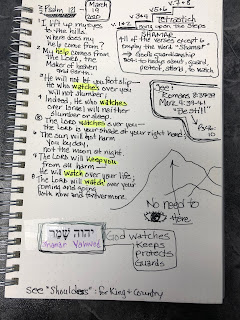Money-Changers and Figs
Mark 11:12–25
12On the following day, when they came from Bethany, he
was hungry. 13 And
seeing in the distance a fig tree in leaf, he went to see if he could find
anything on it. When he came to it, he found nothing but leaves, for it was not
the season for figs. 14 And
he said to it, “May no one ever eat fruit from you
again.” And his disciples heard it. 15 And they came to Jerusalem. And he entered the
temple and began to drive out those who sold and those who bought in the
temple, and he overturned the tables of the money-changers and the seats of
those who sold pigeons. 16 And
he would not allow anyone to carry anything through the temple. 17 And he was teaching them
and saying to them, “Is it not written, ‘My house shall
be called a house of prayer for all the nations’? But you have made it a den of
robbers.” 18 And
the chief priests and the scribes heard it and were seeking a way to destroy
him, for they feared him, because all the crowd was astonished at his teaching.
19 And when
evening came they went out of the city. 20 As they passed by in the morning, they saw the fig
tree withered away to its roots. 21 And
Peter remembered and said to him, “Rabbi, look! The fig tree that you cursed
has withered.” 22 And
Jesus answered them, “Have faith in God. 23 Truly,
I say to you, whoever says to this mountain, ‘Be taken up and thrown into the
sea,’ and does not doubt in his heart, but believes that what he says will come
to pass, it will be done for him. 24 Therefore I tell you,
whatever you ask in prayer, believe that you have received it, and it will be
yours. 25 And whenever you stand praying, forgive, if you have anything
against anyone, so that your Father also who is in heaven may forgive you your
trespasses.”
Jesus cleanses the
Temple of those who do not have the ways of God in mind twice during His
earthly ministry, once at the beginning, and now before His death. This passage
is important because in these two incidents (the cursing of the fig tree and
the cleansing of the Temple) Jesus expounds on His anger at the Jewish
leadership for their refusal to believe and embraces the Gentiles and God's
inclusion of them in His Kingdom.
First, Jesus sets up an
object lesson for His disciples by withering a fig tree. As Jesus and the
disciples are leaving Jerusalem to stay in Bethany after the events of Palm
Sunday, they come across a fig tree by the roadside. (The tree’s position by
the road shows that it was not owned by anyone, but just a random tree planted
by natural process.) The tree is in full leaf which means it should have been
filled with figs, as the figs come before the leaves. Jesus had every right to
expect figs on this tree.
When he came to
the tree, he found nothing but leaves—a promise, but no fulfillment. It was
then that Jesus pronounced the curse on the fig tree. The words seem harsh. Was
Jesus taking out his frustration on the tree? Not so. The disciples heard
Jesus’ words. Jesus used the tree as a lesson to prepare his disciples for what
was to happen next in the temple. Then the next morning, he applied it to their
own ministry and life. He let them know that by having blessed them, he had the
right to expect fruit from them in due season.
Wicke,
H. E. ©1988. Mark (pp. 156–157).
Milwaukee, WI: Northwestern Pub. House.
The next day, Jesus
goes into the Temple and clears out all of the money changers and tradesmen who
have set up shop in the court of the Gentiles. In this one action, Jesus lets
the world know that God will not tolerate this treatment of the Gentiles for He
loves them too. The Jewish leadership was gaining wealth off these tradesmen by
charging them rent for their booths or even taking a cut of the profits. None of
this was acceptable in the sight of God. Even in the Old Testament we are
informed that God’s love expands out to all people, not just the Jews.
Isaiah
56:6–7
6“And
the foreigners who join themselves to the Lord, to minister to him, to love the
name of the Lord, and to be his servants, everyone who keeps the Sabbath and
does not profane it, and holds fast my covenant— 7these I will bring to my holy mountain, and make them
joyful in my house of prayer; their burnt offerings and their sacrifices will
be accepted on my altar; for my house shall be called a house of prayer for all
peoples.”
Upon returning to the fig
tree the next day, the disciples marvel at how it has already shrunk to the
roots and Jesus uses this tree to explain the power of prayer. The other Gospel
writers also make note of the usage of this event to show God’s displeasure at
the Jewish leadership for their rejection of the Messiah. Their power and
impact would wither while those who believe would be blessed with answers to prayers prayed in faith.



Comments
Post a Comment